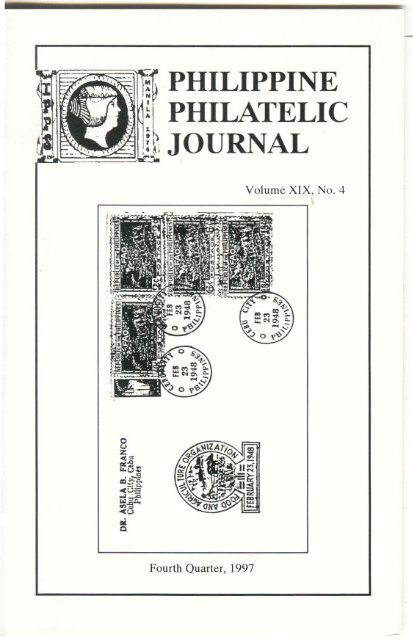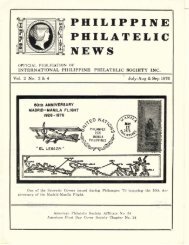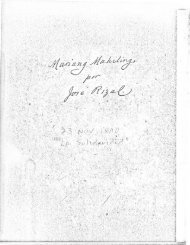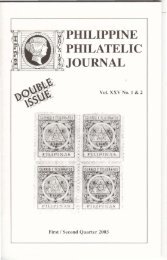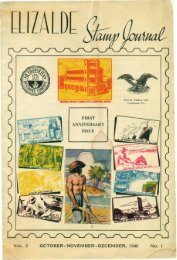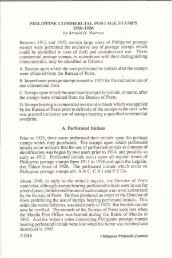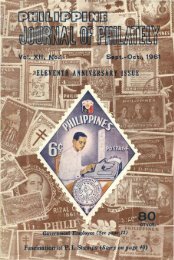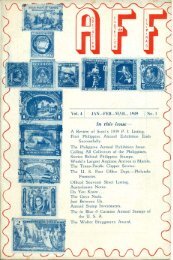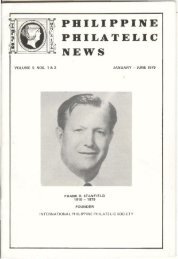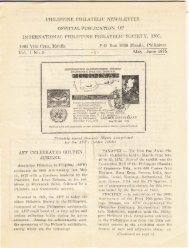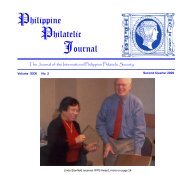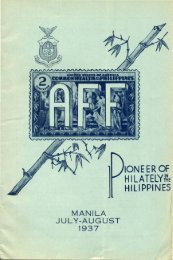Fourth Quarter 1997 - International Philippine Philatelic Society
Fourth Quarter 1997 - International Philippine Philatelic Society
Fourth Quarter 1997 - International Philippine Philatelic Society
Create successful ePaper yourself
Turn your PDF publications into a flip-book with our unique Google optimized e-Paper software.
~~~::l-~--<br />
PHILIPPINE<br />
PHILATELIC<br />
1<br />
.~~: JOURNAL<br />
Volume XIX, No.4<br />
<strong>Fourth</strong> <strong>Quarter</strong>, <strong>1997</strong>
PHILIPPINE PHIlATELIC JOURNAL<br />
Official publication of<br />
<strong>International</strong> <strong>Philippine</strong> <strong>Philatelic</strong> <strong>Society</strong><br />
Dedicated 10 the Study and Advancement of <strong>Philippine</strong>s Philately<br />
American <strong>Philatelic</strong> <strong>Society</strong> Affiliate No. 54<br />
Member, <strong>Philippine</strong> <strong>Philatelic</strong> Federation (PPF)<br />
Volumt: XIX<br />
No.4<br />
<strong>Fourth</strong> <strong>Quarter</strong>, <strong>1997</strong><br />
1996 IPPS Officers:<br />
President<br />
Stanley Chan<br />
Vice President<br />
John Hunt<br />
Secretary........ .. Mario Que<br />
Treasurer . Tony So<br />
Auditor<br />
Nemi Rivera<br />
P.R.O<br />
Larry N. Carino<br />
Directors.. ..Col. Gustavo C. Ingles<br />
Quintin Tan<br />
Rene Mercado<br />
Josie Cura<br />
Roger Quistol<br />
Affiliate Representatives:<br />
Cebu <strong>Philatelic</strong> <strong>Society</strong><br />
- Federico Ferraris<br />
Quezon City <strong>Philatelic</strong> <strong>Society</strong><br />
- Alfredo Principe<br />
Young Philatelists <strong>Society</strong><br />
- Edison G. Cornejo<br />
Appointive Officers:<br />
Auction Commiuee<br />
• AnlonioSo<br />
Membership Committee<br />
- Severino Bajar<br />
Ways & Means Committee<br />
- Raymond See<br />
F.I.P. Represcntaive<br />
- Mario O. Que<br />
Senior Editor<br />
Robert F. Yacano<br />
P.O. Box 94, Eden. NY 14057<br />
News Letter Editor<br />
Richard D. Miggins<br />
P. O. Box 8335<br />
Universal City, CA 91618<br />
Librarian<br />
Daniel F. Ring<br />
P.O. Box 113, Cary, IL 6oo!3<br />
Chairman, US Auctions<br />
David A. McMurtrie<br />
P.O. Box 443, Plainfield, IL 60544<br />
APS Representative<br />
David S. Durbin<br />
1608 S. 22nd Street<br />
Blue Springs, MO 64015<br />
Advertising Manager<br />
Donn A. Lueck<br />
P.O. Box J1582<br />
Phoenix, AZ 85061<br />
IPPS Dues Struclun:<br />
Regular Membership US S25.00<br />
Contributing Membership US 530.00<br />
Sustaining Membership US S35.00<br />
Overseas Membe~ (IE. Phil~ppines, Canada)<br />
Regular, via air mail US 530.00<br />
Contributing Membership US S35.00<br />
Sustaining Membership US 540.00<br />
The <strong>Philippine</strong> <strong>Philatelic</strong> Journal is publisht:d<br />
quarterly by the <strong>International</strong> <strong>Philippine</strong> <strong>Philatelic</strong><br />
<strong>Society</strong>. A non-profit, non-stock, educational<br />
organization, the IPPS was incorporated<br />
in the City of Manila on Sepl. 24, 1978, as per<br />
SEC registration No. 58004. PPJ PURPOSE:<br />
"to publish, on a quarterly basis, original and<br />
reprinted material pertaining to the philately of<br />
the <strong>Philippine</strong>s." ManuscriplS and submissions<br />
should be typed and double spaced on one side<br />
of the page only. 1I1ustrations should be black<br />
and white photographs or very clear photocopies.<br />
Send all material 10 the Edilor.<br />
<strong>Philippine</strong> PhilaJelic Journal
UNITED STATES MILITARY STATIONS: THE<br />
POSTAL MARKINGS OF CEBU<br />
by Nestor C. Nunez and Alfred F. Kugel<br />
(Third in a series. The first part appeared in No.3, 3rd <strong>Quarter</strong>,<br />
1996 and the second in No.2, 2nd <strong>Quarter</strong>, <strong>1997</strong>.)<br />
After occupying the town of Iloilo (Panay Island) on February 11,<br />
1899, the instruction of Gen. Marcus Miller (of the 1st Separate<br />
Brigade ofthe 8th Army) (1) was to proceed to the town ofCebu (Cebu<br />
Island) and similarly occupy it. To this end, the Petrel was sent there<br />
from Iloilo. As in the case of Iloilo, resistance was expected, but the<br />
occupation of the town was achieved without bloodshed.<br />
The situation in Cebu at that time, as related by the German consul to<br />
Faust (2): "There was a stormy meeting of the townspeople on<br />
February 17 upon hearing of the approach of the Americans. The<br />
young men advised the burning of the town and fighting to the bitter<br />
end, but the older men advised calmer councils. There was a second<br />
meeting at noon and the wiser heads prevailed. On February 21, the<br />
Petre/was seen, and prominent local persons Llorente, Majie, Garardo,<br />
Qui and Climaco, leaders of Cebu, went out to meet her. When told<br />
by Mr. Sidebottom, English Consul, who was acting for the American<br />
government about the intentions of the Americans, Majie said that<br />
"the people ofCebu, finding themselves abandoned by the Spaniards,<br />
have joined the Filipino republic." TheCommanderofthe Petrel gave<br />
them until eight o'clock on February 22 to surrender. A great many<br />
were in favor of burning the town, but at seven o'clock on the night<br />
of February 21, it was agreed under the influence of Majie and<br />
Llorente, to yield to superior force and to give up the town, but under<br />
TABLE OF CONTENTS<br />
Vol. XIX No.4 <strong>Fourth</strong> <strong>Quarter</strong>, <strong>1997</strong><br />
United States Military Stations: The Postal Markings of Cebu<br />
by Nestor C. Nunez and Alfred F. Kugel Page 1<br />
Cebu Bisected Stamps by Col Gustavo C. Ingles Page 9<br />
United States Military Stations:<br />
The Postal Markings of Bacolod<br />
by Nestor C. Nunez and Alfred F. Kugel Page 11<br />
Twelfth Major Error Reported of The Spanish <strong>Philippine</strong> 1890<br />
1897 Issue: Scratched Plate Flaw on THree Scott #150 Positions<br />
by Don Peterson Page 18<br />
<strong>Philippine</strong> <strong>Philatelic</strong>Journal 1
protest, stating that they had no order from Aguinaldo to that effect<br />
(3). At 8:30 a.m. on February 22, they sent word to the commander of<br />
the Petrel. At 9:30 forty sailors were landed, and at 9:40 the Stars and<br />
Stripes were hoisted over Cebu.<br />
On February 28, the 1st Battalion of the 23rd Infantry under Major<br />
George S. Goodale left Manila for Cebu, arriving on March 1. To<br />
quote Goodale: "We left Manila for Cebu on only a few hours' notice<br />
and possibly there was no time for a postal agent to accompany us.<br />
However, one arrived soon thereafter. In the interim all mail was<br />
handled by the military authorities. The post office was opened May<br />
1,1899" (4). In the Hoge (5) photocopy archives is a cover sent by<br />
Goodale to Colfax, California with a Manila small steel postmark of<br />
March 8,1899. At the back ofthe cover is this notation in manuscript:<br />
"From Cebu before it was Military Station No.4." This cover gives<br />
a likely indication that the first mails from Cebu might have been sent<br />
to Manila without local processing. Local military personnel would<br />
have processed mail shortly thereafter, as the Cebu DS1 and US1,<br />
have been recorded as early as March 17, 1899. It is reasonable to<br />
assume that Cebu became a military postal station on May 1, 1899<br />
(date of opening of the post office per Goodale).<br />
Cebu was the 2nd District Headquarters of the Department of the<br />
Visayas, United States Army, in March 1900. Col. Hamer ofthe Idaho<br />
regiment was initially the military governor. Civil government was<br />
established April 18, 1901; restored to the military July 17, 1901; and<br />
restored to civil government January 1, 1902 (6).<br />
2 <strong>Philippine</strong> <strong>Philatelic</strong> Journal
The following are the recorded postmarks ofCebu, including postage<br />
due and auxiliary markings.<br />
DS1. Double-ring rubber canceller<br />
with "1" deleted. This device<br />
was first used in Manila, which<br />
was Military Station No. 1. (7).<br />
Seen used in Cebu always with<br />
US 1, but similar devices (also<br />
with" 1 "deleted)were also used<br />
in Iloilo and in Bacolod as stand<br />
alone postmarks. This combination<br />
has also been seen as a receiving<br />
mark (earliest March 17,<br />
latest April 10, 1899). Struck in<br />
black or blue black.<br />
Earliest: March 16, 1899<br />
Latest: May 1, 1899<br />
".ST4<br />
'v' '1-<br />
;; AUG 0<br />
31<br />
1899<br />
('["8u, ~ \<br />
\.-t.Elu<br />
AUG<br />
20<br />
lOAM<br />
1900<br />
F> . \<br />
~<br />
--<br />
........<br />
-<br />
DS2. Single-ring rubber<br />
datestamp 29 mm, with three<br />
horizontal bar killers 16 mm<br />
wide. Struck in purple or red<br />
purple or black (March 6, 1900<br />
usage). Also used as a receiving<br />
cancel.<br />
Earliest:: May 6, 1899<br />
Latest: September 1, 1900<br />
DS3. Single-ringsteel datestamp<br />
29 mm. Eight bar barrel killer.<br />
"Standard" type of civil government<br />
postmarks. Seen with year<br />
slug inverted (June 19, 1900).<br />
Struck in black.<br />
Earliest: April 3, 1900<br />
Latest: used well beyond July 4,<br />
1902<br />
<strong>Philippine</strong> <strong>Philatelic</strong> Journal 3
d<br />
USI. Undated double-ring stamp,<br />
used as postal station identifier together<br />
with DS1, or as an early receiving<br />
stamp. In his article (4),<br />
Goodale mentioned a "cover from<br />
California to Cebu with a Manila<br />
postmark ofApril 10, 1899" and this<br />
postmark (US1) as a receiving mark<br />
(8).<br />
Earliest: March 16, 1899<br />
Latest: May I, 1899<br />
RCI. Single-ring rubber datestamp<br />
30 mm, with "REC'D" at bottom of<br />
dial. A cover in the Kugel collection<br />
shows this mark used as a canceller<br />
on July 5, 1900, on registered mail to<br />
Leipzig on July 5, 1900, with RG I.<br />
Struck in purple (per Goodale) or<br />
black, or blue black.<br />
Earliest: May 25, 1899<br />
Latest: November 20, 1900<br />
REGISTERED<br />
MAR 6 1901<br />
Military Station No.4,<br />
Cebu, Phil. Islands.<br />
RG1. Four-line registration stamp of<br />
mixed seriffed and non-seriffed capital<br />
and small letters 4 to 5 mm tall,<br />
lines 39 to 41 mm long. Generally<br />
used with dumb killers obliterating<br />
the stamps. Color unknown.<br />
Earliest: June 2, 1899<br />
Latest: December 11, 1901<br />
A<br />
RG2. Thick, non-serif capital letter<br />
"R" sometimes used with RG1, and<br />
preceded or followed by the registration<br />
number in Cebu. (Registered<br />
letters normally also receive another<br />
registry control number in Manila).<br />
Color of strikes unknown.<br />
Earliest: June 2, 1899<br />
Latest: December 30, 1899<br />
4<br />
<strong>Philippine</strong> PhilDtelic Journal
RG3. Double-circle registered cancel,<br />
civilian government type, 30 mm<br />
outer circle diameter. Seen used with<br />
indistinct obliterator, which look like<br />
AX3.<br />
Earliest: May 9, 1902<br />
PDl. State I. "POSTAGE<br />
DUETWO CENTS" in capital<br />
Roman letters 3 mm tall,<br />
62 mm long. Appears to be<br />
made from rubber. Presum-<br />
ENT S ably, there was more than<br />
POSTAG E DU E TWO C . one device of this type (see<br />
State II, recorded used before<br />
the latest recorded use<br />
of State I). Struck in black.<br />
Earliest: June 6, 1899<br />
Latest: October 19,1901<br />
PO 1. State II. As in State I,<br />
but with "TWO" excised,<br />
POSTAGE DUE CENTS. creating a space for manuscript<br />
marking of the postage<br />
due charge.<br />
Earliest: October 12, 1899<br />
PD2. "POSTAGE DUE<br />
TWO CENTS" in capital<br />
Roman letters 3 mm tall, in a<br />
wavy line 60 mm long (horizontal<br />
length). Appears to<br />
be made ofrubber. Thewavy<br />
POSTAGE DUE TWO CENT::>. line does not appear to bethe<br />
result of disto.rtion of the<br />
rubber in hot weather, as the<br />
letters are of even height,<br />
and are in upright position<br />
even when at thewavecurve.<br />
Used concurrently with POI.<br />
Struck in black.<br />
Earliest date: October 15,<br />
1900<br />
Latest date: December 21,<br />
1900<br />
<strong>Philippine</strong> PhikJJelic Journal 5
POSTAGE DUE, 2<br />
PD3, "POSTAGE DUE, 2<br />
crS." in non-seriffed capital<br />
block letters 5 mm tall, 60 mm<br />
long. Appears to be made of<br />
rubber. The single impression<br />
CTS. seen (9) show significant deterioration<br />
in the letters, and the<br />
illustration has been enhanced<br />
for clarity. Struck in Violet.<br />
Earliest date: April 3, 1900.<br />
AX1. "Parilla" or oval grill dumb<br />
obliterator used during the early years<br />
of the Spanish colonial stamp period,<br />
used as canceller with RGl.<br />
While the usage seen is late in the<br />
military period, this mark is listed<br />
first due to the device's earlier existence.<br />
Probably struck in black.<br />
Latest: March 6, 1901<br />
.._.<br />
.... •••<br />
.-'.<br />
AX2. Diamond segmented killer, cut<br />
from a circular block24 mm in diameter<br />
and sliced into 20 diamonds.<br />
Used in conjunction with RGl.<br />
Struck in blue black.<br />
Earliest: November 13,1899<br />
Latest: June 13, 1901<br />
AX3. Twelve uneven solid bars, 16 x<br />
14 mm in the aggregate, probably<br />
made from solid irregular rubber and<br />
cut into sections. Seen used with<br />
RG1 on December 11, 1901.<br />
Earliest: December 11, 1901<br />
Collectors of this area and other readers are encouraged to look into<br />
their collections with a view of adding types not included in this<br />
article, and/or extending the earliest or latest dates. Information<br />
should be sent to the authors at P.O. Box 12, San Mateo, CA 9440l.<br />
Postage and photocopy (preferably color) costs to be reimbursed, and<br />
credits to be attributed. (Copyright reserved by the authors).<br />
6 <strong>Philippine</strong> <strong>Philatelic</strong> Journal
PlllLll'rL."\ES.<br />
DS2 Cancellation on cover to Pennsylvania<br />
POSTMARK LIST CONCORDANCE<br />
Nunez/Kugel Goodale (4)<br />
DS1<br />
DS2<br />
A-2<br />
DS3<br />
A-3<br />
US1<br />
A-I<br />
RCI<br />
RC-I<br />
RGl<br />
RG-I<br />
RG2<br />
RG3<br />
POl S.I<br />
PDl S.ll<br />
PD2<br />
PD3<br />
AXI<br />
AX2<br />
AX3<br />
<strong>Philippine</strong> PhilDtelic Journal<br />
Baker (10)<br />
C-2<br />
CA-2<br />
CE-2<br />
SR-2<br />
7
ENDNOTES:<br />
1. According to Faust (see endnote No.2), the "Separate Brigade"<br />
was created by Gen. Elwell Otis "within the meaning of the 73d<br />
Article of War and designated as the 1st Separate Brigade of the<br />
8th Army Corps." The brigade was initially sent to Iloilo in<br />
December 1898, remaining in the transports at Iloilo Harbor until<br />
February 11, 1899 when it took possession of Iloilo after bombardment<br />
of Filipino positions.<br />
2. Faust, Karl Irving, Campaigning in the <strong>Philippine</strong>s, The Hicks<br />
Judd Publishing Company, San Francisco, 1899.<br />
3. Prior to the coming of the American forces, the islands of Panay,<br />
Negros and Cebu (locations ofthe major towns ofIloilo, Bacolod<br />
and Cebu) formed the "Visayan Republic," a step into independent<br />
self government after the collapse of Spanish authority.<br />
Based on the earlier incident in Iloilo, where the local officials<br />
refused permission to the American expeditionary force to land<br />
without orders from Gen. Emilio Aguinaldo, and the comments of<br />
the local leader Majie in Cebu, this "Visayan Republic" recognized<br />
the government of Aguinaldo as the legitimate national<br />
government.<br />
4. Goodale, George S., "U.S. Military Postal Stations in the <strong>Philippine</strong>s<br />
(1898-1904)," Cyclopedia oJ United States Postmarks,<br />
edited by DelfNorona, <strong>Quarter</strong>man Publications, Lawrence, MA,<br />
1975.<br />
5. Correspondence of March 5 <strong>1997</strong> from Robert C. Hoge, whose<br />
covers and photocopy archives have been enormously helpful in<br />
developing this article. The authors would like to acknowledge<br />
the help from other <strong>Philippine</strong> specialists, especially the opportunity<br />
to view actual covers or photocopies of the collections of<br />
Capt. Weston Burnett, Wolfgang Haberland, Fritz-Walter Lange,<br />
the late Lynn Warm-Griffith, and Robert F. Yacano.<br />
6. Dates are from Goodale. While the occupation ofthe city ofCebu<br />
was accomplished without bloodshed, the pactfication of the<br />
island of Cebu did not come easily. This is probably the reason<br />
why the government had to be restored to military rule for some<br />
six months in 1901. Faust wentto Cebu in the course ofwriting his<br />
book, and notes that in Cebu "the insurgents have become active<br />
again, and at the date of the publication of this volume [1899], is<br />
fighting going on with what results cannot yet be ascertained."<br />
8 <strong>Philippine</strong> Philatelie Journal
7. Nunez, Nestor c., <strong>Philippine</strong>-American War: "IslandHopping" <br />
ofa u.s. Military Cancel: Additional Notes, unpublished manuscript<br />
which makes additional comments on the use of the OS1<br />
device which was the subject ofan article by Haberland, Wolfgang,<br />
American <strong>Philippine</strong> War 1899-1902, Island Hopping by a US<br />
FieldPostCancel(translated by c.A. Richmond from "Rundbrief<br />
USA"), Possessions, published by the United States Possessions<br />
<strong>Society</strong>, Vol. 17 No.1, Whole 59, First <strong>Quarter</strong> 1994. It is curious<br />
that Goodale did not include this datestamp among his list of<br />
postmarks (see Endnote 8). The Nuiiezcollection has a cover from<br />
Goodalesentto Laredo, Texas with US1 and OS1 dated March 17,<br />
1899. The Kugel collection also has these combination uses in a<br />
postcard to Zurich postmarked March 20, and as receiving marks,<br />
dated March 17, 1899.<br />
8. The Hoge photocopy archive has a U.S. One Cent Grant postal<br />
card with paid reply, which was sent from Grass Valley, CA on<br />
February 23, 1899 to Goodale (addressed to Manila). The card<br />
was evidently forwarded to Cebu (where Goodale was stationed<br />
from March 1) and postmarked on receipt on April 10 (OS1 and<br />
USl strikes). This is most likely the "cover" that Goodale referred<br />
10, and he mistakenly supposed that the OS1 strike was a Manila<br />
receiving mark.<br />
9. Correspondence from Capt. Weston O. Burnell, August 27,<strong>1997</strong>.<br />
10. Baker, Philip E., Postal Markings of United States Military<br />
Stations, 1898-1902, 1963.<br />
CEBU BISECTED STAMPS<br />
By Col. Gustavo C. Ingles<br />
Bisected stamps are stamps which are cut into halves to allow usage<br />
of part, normally fifty (50) percent, of its face value. (COVER) This<br />
mode of payment for postal charges is authorized in some countries<br />
in case of shortage of stamps of the required denomination. Its<br />
employment has never been authorized by the Postmaster General of<br />
the <strong>Philippine</strong>s. There was an instance, however, when it was employed<br />
in Cebu City in the <strong>Philippine</strong>s after 1945 due to extreme<br />
shortage of stamps of the required denomination.<br />
Cebu City was the second largest city in the <strong>Philippine</strong>s after World<br />
War II. It was forced to use bisected stamps early in 1948 due to the<br />
absence of the necessary two-centavo stamps for its domestic mail<br />
service.<br />
<strong>Philippine</strong> Philnlelic Journal 9
As early as the middle of 1947, the acting Postmaster, Me. Andres<br />
Abella noticed that the supply of two-centavo stamps received from<br />
Manila was very much lower that the quantity requisitioned. Repeated<br />
requests to the central post office to increase his supply remained<br />
unheeded. His supply of two-centavo stamps was depleted during<br />
Christmas 1947 and with the advent of the New Year his stock was<br />
practically zero.<br />
To keep the Cebu Post Office functioning, he authorized the use of<br />
half of the four-centavo stamp with the Rizal Monument design (to<br />
check Scott #50) starting January 5, 1948. At the beginning he took<br />
pains to sign all envelopes with the bisected stamps. However, later,<br />
when the volume of the mail increased, he stopped this practice. The<br />
postal service ofCebu continued the use ofbisectedstamps until it was<br />
stopped by the Postmaster General. Me. Abella was severely reprimanded<br />
administratively. Since Me. Abella felt that his action was for<br />
the good of the service, he took the case to the local court.<br />
I<br />
J<br />
The presiding judge not only absolved Me. Abella but commended<br />
him for his initiative and dedication to his duty. The initiative of Me.<br />
Abella has been the subject ofdiverse opinion up to the present. It also<br />
created a unique situation in <strong>Philippine</strong> philatelic history.<br />
Very few philatelists in Cebu saw the significance of the "bisected"<br />
stamps. Among the philatelists with foresight were Don Bitong Reyes<br />
and Dra. Acela Franco who made first day covers.<br />
A young collector then, Me. Philip Liap helped these two collectors by<br />
cutting the stamps and mounting them on the covers. Stamp collector/<br />
dealer Me. Rodrigo Velez also made first day covers. Between the<br />
three ofthem, around four hundred covers; single double and block or<br />
four bisects were prepared. Foreign collectores in Cebu, at that time,<br />
were paying at least five dollars per piece for used commercial covers.<br />
There is no record available as to the duration the bisected stamps<br />
were used. One cover in my possession was cancelled May 31st 1948<br />
on a PLDT (<strong>Philippine</strong> Long Distance Telephone) window envelope.<br />
I<br />
J<br />
10 <strong>Philippine</strong> <strong>Philatelic</strong> Journal
UNITED STATES MILITARY STATIONS: THE<br />
POSTAL MARKINGS OF BACOLOD<br />
by Nestor C. Nunez and Alfred F. Kugel<br />
I<br />
1<br />
While Manila and the Central Plain of Luzon are considered the<br />
heartland of the <strong>Philippine</strong>s, the Visayan Islands at the time of the<br />
<strong>Philippine</strong>-American War was an equally important part of the<br />
country in terms ofpopulation and mercantile activities. More importantly<br />
from a military viewpoint, these islands were also a hotbed of<br />
revolutionary fervor. Prominent in this island group are the islands of<br />
Panay, which had the provinces of Antique, Capiz, Iloilo and<br />
Concepcion (this province was later incorporated into Iloilo); Negros,<br />
divided into Negros Oriental and Negros Occidental; and Cebu, an<br />
island province. The major towns,now cities,in these islands are Iloilo,<br />
Bacolod, and Cebu. These three islands had a total population of<br />
1,666,000 (1), compared to thatofLuzon of3,563,000. Iloilo (473,000)<br />
and Cebu provinces (504,000) had more population than the province<br />
of Manila (400,000) (2).<br />
With the collapse of Spanish authority as a result of the Spanish<br />
American War and the resumption of the <strong>Philippine</strong> revolution after<br />
Aguinaldo's return from exile in Hong Kong, a "Visayan Republic"<br />
was set up, composed principally of these three islands. The capital<br />
was Iloilo city, after its capture from the Spanish in December 1898<br />
(3). After the Spanish surrendered Manila on August 13, 1898, the<br />
Spanish forces there retreated to Iloilo. In the interim period, American<br />
and Spanish delegates met in Paris to negotiate the terms of the<br />
peace treaty. During this period, it became evident that the U.S.<br />
wanted to obtain possession of the entire country.<br />
Back in Panay Island, the Spanish forces were beleaguered by the<br />
Filipino revolutionists to the point where the Spanish commander in<br />
Iloilo had to send a message to Gen. Elwell Otis that he could no longer<br />
hold out against the insurgents. Otis responded by creating a Separate<br />
Brigade (4), which proceeded to the Iloilo on December 26, 1898.<br />
After the signing ofthe Treaty of Paris on December 10, the Visayan<br />
Islands became a logical target for American occupation. Thus,<br />
sending an expeditionary force to these islands was a sound military<br />
move as well, sinceAmerican occupation would presumably snuffthe<br />
revolutionary fervor there, thereby ensuring that not many troops<br />
would need to be diverted from Luzon, which presented a greater<br />
military problem with the then uneasy relationship with Emilio<br />
Aguinaldo's revolutionary army.<br />
<strong>Philippine</strong> PhilaJelic Journal 11
The occupation of the town of Iloilo was delayed by the unfriendly<br />
reaction ofthe local population, and was only forcibly accomplished<br />
on February 11, 1899 following the start of hostilities between the<br />
Americans and Filipinos on February 4. Occupation of the town of<br />
Cebu followed on February 28 without bloodshed. The occupation of<br />
the the town of Bacolod came about in a different fashion, and was<br />
probably influenced by the earlier events leading to the American<br />
takeover of Iloilo and Cebu.<br />
The following is essentially summarized from Faust (5): The local<br />
authorities in Negros were more amicable and more in hearty accord<br />
with American domination that those of Panay and Cebu. The<br />
inhabitants had earlier been in revolt against, and had practically<br />
overturned Spanish authority. On November 12, 1898, a provisional<br />
government made up ofthirty six deputies had been established with<br />
Aniceto Lacson, President and Jose Luis Luzurriaga, President ofthe<br />
native congress. A cabinet was also created with functions "similar to<br />
that in all republican governments." Preceding American occupation,<br />
a deputation of these officials, including Lacson, approached Gen.<br />
Otis with their desire for amicable establishment ofAmerican rule in<br />
the island. Thus the coming of the Americans was a welcome event,<br />
"rather than a reluctant submission of a defeated people." Col. (later<br />
Gen.) James H. Smith of the California Volunteers was appointed by<br />
Gen. Elwell Otis (6) to be the military governor. Smith, with the 1st<br />
Batallion of the California Volunteers under Maj. Hugh T. Sime,<br />
proceeded with the transport St. Paul from Manila, and landed in<br />
Bacolod on March 4,1899. Largely due to the welcome manner of its<br />
takeover, the Americans strove to give the people of Negros the<br />
"largest liberty compatible with the military occupation" by the<br />
United States. Gov. Smith took exclusive control of customs, post<br />
office, telegraph and police functions while all other civil affairs were<br />
left in the hands of Filipinos (7).<br />
According to Goodale (8) Bacolod was the 3rd District Headquarters<br />
of the Department of the Visayas, U.S. Army, in March 1900. Civil<br />
government was established in Negros Occidental on April 20, 1901.<br />
Goodale noted that the Bacolod military post office was a small one,<br />
as there was not more than a company ofinfantry being stationed there<br />
at a time.<br />
The following are the recorded postmarks of Bacolod, which was<br />
military postal station number five.<br />
12 <strong>Philippine</strong> PhiJaJelic Journal
.
:<br />
DS 3. Single-ring rubber<br />
datestamp 35 mm. Similar to DS<br />
2, but larger, with lellers 4 mm<br />
::: tall, with three thick horizontal<br />
bar killers 15 mm wide. First<br />
reported by Howell (10).<br />
---<br />
-.'<br />
"".5.9..,,,<br />
......... OCT 0....<br />
" 29 ~.<br />
1899 -0'<br />
.'-<br />
REGISTERED<br />
FEB 28 1902<br />
Military Station No.5.<br />
BACOLOD. P. I.<br />
Earliest: February 12,1900<br />
Latest: July 10, 1900<br />
DS4. Single-ringsteel datestamp<br />
29 mm, with eight bar barrel<br />
killer. "Standard" type of civil<br />
government postmarks. Struck<br />
in black.<br />
Earliest: January 12,1901<br />
Latest: used well beyond<br />
July 4,1902<br />
RCI. Single-ring rubber<br />
datestamp 30 mm. with<br />
"REC'D" at bollom of the dial.<br />
Struck in black.<br />
Earliest: May 12, 1899<br />
Latest: October 29, 1899<br />
RGl. Four-line registration rubber<br />
datestamp postmark in nonseriffed<br />
block capital and small<br />
letters, with maximum width 42<br />
mm. Seen used as receiving mark<br />
(January 31,1902). Struck in violet<br />
or purple.<br />
Earliest: October 17, 1899<br />
Latest date: February 28, 1902<br />
POSTAGE DUE TWO CENTS.<br />
PDl. "POSTAGE DUE<br />
TWO CENTS." in capital<br />
Roman letters 3 mm<br />
tall. Postmark made of<br />
rubber. Struck in violet<br />
14 <strong>Philippine</strong> <strong>Philatelic</strong> Journal
-<br />
••<br />
--<br />
•<br />
Earliest date:<br />
May 27,1899<br />
Latest date:<br />
October 6, 1899<br />
AX1. Seen used with RG<br />
1. Struck in violet<br />
Earliest date: October 17,<br />
1899<br />
AX 2. Eight bar ovalled<br />
rubber obliterator, seen<br />
used with RGl. Struck in<br />
purple.<br />
Earliest date: February<br />
28, 1902<br />
, '~;,
Goodale notes that a few covers are<br />
known which passed through territory<br />
controlled by the Filipino insurgent<br />
government, and lists his F-l type cancel,<br />
reproduced at left (illustration not<br />
exact per Goodale).<br />
Prior to the arrival ofAmerican forces<br />
in Negros island, revolutionary mail<br />
bearing the postmark illustrated at left<br />
was sent from there to Iloilo.<br />
"COMUNICs YTELEGRAFs" means<br />
Communications (Post) and Telegraphs.<br />
The cover received an Iloilo<br />
DSI arrival mark ofFebruary 28,1899,<br />
and was recently sold at the Philstamps<br />
auction in June <strong>1997</strong> (Lot 428A).<br />
Collectors (12) and other readers of this area are encouraged to look<br />
into their collections with a view of adding types not included in this<br />
article, and/or extending the earliest or latest dates. (Copyright reserved<br />
by the authors).<br />
DS2 and PDl postmarks on unfrankedcover<br />
16 <strong>Philippine</strong> PhiWelicJournal
•<br />
POSTMARK LIST CONCORDANCE<br />
NUfieziKugel Goodale (4) Baker (10)<br />
DSI<br />
DS2<br />
A-I<br />
C-2<br />
DS3<br />
DS4<br />
RCI<br />
RC-I<br />
RGI<br />
SR-5<br />
PDl<br />
PDl<br />
AXl<br />
AX2<br />
F-l<br />
ENDNOTES:<br />
1. Population figures are from Fausr (Endnote 5).<br />
2. Under the Spanish system of JXllitical subdivisioCb, Manila W~ a proVince: with<br />
population mainly in the suburbs, which included Binondo, Santa Cruz, Quiapo,<br />
San Miguel, and Tondo.<br />
3. After losing IInilo, which became the Spanish capital in the <strong>Philippine</strong>s following<br />
the fall ofManila, theSpanish forces retreated to the garrisonedcity ofZamboanga,<br />
or to Jolo, where they remained until repatriation in May 1899 or relieved by<br />
American forces in November 1899.<br />
4. See "United States Military Stations: The Postal Markings of Iloilo," second<br />
article in this series, <strong>Philippine</strong> <strong>Philatelic</strong> Journal, Vol. XIX, NO.2.<br />
5. Faust, Karl Irving, Campaigning in the <strong>Philippine</strong>s, The Hicks-Judd Publishing<br />
Company, San Francisco, 1899.<br />
6. Maj. Gen. Elwell Otis became the military commander ofthe American forces in<br />
late August 1899, following the return ofMaj. Wesley Gen. Merritt to the United<br />
States. Merritt only stayed some three weeks in Manila. He disagreed with his<br />
superior, Maj. Gen. Nelson Miles, army chief, on the military strategy over the<br />
islands.<br />
7. While the takeover of Bacolod was without bloodshed, the rest of the population<br />
did not necessarily welcome the American authority. Faust lists several armed<br />
clashes with "unsubdued class of brigands," including the fight in the capture of<br />
Labzid by U. Col. Victor D. Duboce, an action at Bobong resulting in 115 local<br />
insurgents killed, and a sharp engagement at Tibunan, with 19 insurgents dead.<br />
8. Goodale, George S., "U.S. Military Postal Stations in the <strong>Philippine</strong>s (1898<br />
1904)," Cyclopedia of United States Postmarks, edited by Delf Norona,<br />
<strong>Quarter</strong>man Publications, Lawrence, MA, 1975.<br />
9. Nunez, Nestor c., <strong>Philippine</strong>-American War: "Island Hopping" of a us.<br />
MiliJary Cancel: Additional Notes, unpublished manuscript which makes additional<br />
comments on the use of DS1 devise which was the subject ofan article by<br />
Haberland, Wolfgang,American <strong>Philippine</strong> War 1899-1902, Island Hopping by<br />
a US Field Post Cancel (translated by c.A. Richmond from "Rundbrief USA''),<br />
Possessions, published by the United States Possessions <strong>Society</strong>, Vol. 17 No.1,<br />
Whole 59, First <strong>Quarter</strong> 1994.<br />
10. Howell, David 0., Postal Markings Used in Isle de Negros, 1899-1902, War<br />
<strong>Philippine</strong> Phi/Dtelic Journal 17
Cov~r Club Bulktin, Vol. XVIII, No.6, Aug.-Sep. 1978, publisbed by lb~ WaI<br />
Cover Club (now MilitaIy Postal History <strong>Society</strong>). Howell's article led many<br />
collectors and students of this period to believe Ibat tbe DSI device was only used<br />
in Bacolod. The Haberland article mentioned in Endnote 9 arrived at different<br />
conclusions, but were being corrected by lbe unpublisbed Nunez article.<br />
II. Goodale's illustration of this postmaIk (his A-I) sbows a four-bar killer.<br />
12. The authors would like to acknowledge the help from other <strong>Philippine</strong> specialists,<br />
especially the opportunity to view actual covers or photocopies oflbe collections<br />
ofCapl. Weston Burnett, Wolfgang Haberland, Fritz-Walter lange, the late Lynn<br />
Warm-Griffith, Robert F. Yacano and particularly Robert C. Hoge, who also<br />
supplied some of the eaIliest/latest dates.<br />
13. Baker, Philip E., Postal Markings ofUnited States Military Stations, 1898-1902,<br />
1963<br />
(<strong>Fourth</strong> in a series. The first part appeared in No.3, 3rd <strong>Quarter</strong> 1996, the<br />
second in No.2, 2nd <strong>Quarter</strong> <strong>1997</strong> and the third pari in this issue)<br />
TWELFTH MAJOR ERROR REPORTED OF THE<br />
SPANISH PHILIPPINE 1890-1897 ISSUE:<br />
SCRATCHED PLATE FLAW ON THREE SCOTI'<br />
#150 POSITIONS<br />
by Don Peterson<br />
Eleven major errors of the 1890-1897 issues have previously been<br />
reported (<strong>Philippine</strong> <strong>Philatelic</strong> News, Vol. XI, No.4, <strong>Fourth</strong> <strong>Quarter</strong><br />
1989; and <strong>Philippine</strong> <strong>Philatelic</strong> Journal, Vol. XVII, No.4, <strong>Fourth</strong><br />
<strong>Quarter</strong> 1995). To qualify as a major plating error, the error must be<br />
clearly observable to the average collector, reoccurring or "constant",<br />
and must occur on the same position on the pane from one pane to<br />
another.<br />
Although scratches are occasionally seen on the 1890-1897 issues,<br />
until now, none were known to reoccur on a regular basis ofany issue<br />
from one plate to the next. Recently, through the keen observations of<br />
<strong>Philippine</strong> collectors Craig Chartrand and Sebastian Baldassarre, a<br />
new error (actually three errors) surfaced on Scott#150, the olive gray<br />
2-4/8 centavos 1892 issue. The errors consist of vertical (slightly<br />
diagonal) scratches on three different positions on the full pane ofthis<br />
issue. Scott #150 was printed in sheets of 150, comprised of three<br />
panes of50 (5 x 10), each separated by a gutter. The scratches occur<br />
on the right side ofposition 4, the leftside ofposition 19, and thecenter<br />
ofposition 39 ofeach pane (FIGURE 1). Several complete panes were<br />
inspected and the errors were found on each of the three panes in the<br />
same locations.<br />
18 <strong>Philippine</strong> <strong>Philatelic</strong> Journal
Although the errors are known to occur on different sheets, I do not<br />
believe they were present on the entire printing. This is because the<br />
frequency ofstamps with errors found is less than would be observed<br />
if they had occurred during the entire printing. Therefore, the total<br />
number of errors is estimated, and thus, remains subject to future<br />
adjustments. This error has not been previously reported in the<br />
philatelic literature. The following is a description of the error in the<br />
format of the previous articles.<br />
Description<br />
of Error<br />
J2. Scratched<br />
Plate<br />
(3 postiions)<br />
On<br />
Scott No.<br />
150<br />
Toml No. of<br />
Issue Printed<br />
6,000,000<br />
Total No.<br />
of Errors<br />
60,000<br />
(est.)<br />
Relative<br />
Scarcity<br />
S<br />
* Relative scarcity based on standards $1;;1 in the 1989 article.<br />
If you have any information on this error, please contactDon Peterson,<br />
7408 Alaska Ave., NW, Washington, DC 20012.<br />
_FILIPINA.S_<br />
••<br />
Position 4<br />
(right side)<br />
Position 19<br />
(left side)<br />
Position 39<br />
(center)<br />
FIGURE 1. Three Posillons of Scrarched Plate Error on Scott #150.<br />
<strong>Philippine</strong> Phikllelic Journal 19
Index of<br />
The PHILIPPINE PHIlATELIC JOURNAL<br />
Volume XVIII<br />
SPANISH PERIOD<br />
Charted Bank of India, China and Australia (CBl) Perfins<br />
by Douglas K. Lehmann: No.1, page 4<br />
CBI Perfins Part 2<br />
by Douglas K. Lehmann: No.4, page 16<br />
Ker And Company - A British Business Firm In The Spanish<br />
<strong>Philippine</strong>s 1827-1898<br />
by Don Peterson: No.2, page 10<br />
Updated Description of Spanish <strong>Philippine</strong> "Certificado" Handstamp Types<br />
by Don Peterson: No.1, page 14<br />
AMERICAN ADMINISTRATION<br />
Bill of Health, 1898<br />
by Don Lueck: No.1, page 8<br />
Buddy System Used To Ship Parcels To America<br />
by Bill Grimaud: No.2, page 1<br />
115 First Day Cover: No.1, page 20<br />
Mail From Curregidor, 1942<br />
by Donald D. McPherson: No.3, page 1<br />
United States Military Stations: The Postal Markings of Vigan<br />
by Nestor C. Nunez and Alfred F. Kugel: No.3, page II<br />
REVENUES<br />
Bill of Lading- Album Page: No.4, page 20<br />
Early Cigarette Issues<br />
by Douglas K. Lehmann: No.4, page 7<br />
Mexican Currency Used to Pay <strong>Philippine</strong>s Customs Fee<br />
by Don Lueck: No.4, page 4<br />
JAPANESE OCCUPATION<br />
<strong>Philippine</strong>s - Japanese Occupation WWII Postal Cards - Vehicle For Stamps<br />
by William J. Oliver: No.4, page 1<br />
20 <strong>Philippine</strong> <strong>Philatelic</strong> Journal
Index of<br />
The PHILIPPINE PHIlATELIC JOURNAL<br />
Volume XIX<br />
SPANISH PERIOD<br />
Manila Mark Applied In Mexico<br />
by Geoffrey Lewis: No.3, page 11<br />
Smith, Bell and Company: A British Business Firm In The<br />
Spanish <strong>Philippine</strong>s 1847-1898<br />
by Don Peterson: No.3, page 1<br />
AMERICAN ADMINISTRATION<br />
The End Of The Silver Standard January, 1902 To December 31,1903<br />
by Douglas Lehmann: No.2, page 14<br />
<strong>Philippine</strong> Stationery: The Liberation Of Manila<br />
by Eugene A. Garrett: No. I, page 2<br />
Scott 02 - Does It Exist<br />
by Richard D. Miggins: No.3, page 18<br />
United States Military Stations: The Postal Markings Of Iloilo<br />
by Nestor Nuiiez and Alfred F. Kugel: No.2, page I<br />
REVENUES<br />
The 1905 & 1906 Internal Revenue Series<br />
by Douglas K. Lehmann: No.2, page 19<br />
JAPANESE OCCUPATION<br />
Japanese Occupation Envelopes: Quite Common And Exceedingly Scarce<br />
by Eugene A. Garrett: No. I, page 13<br />
Japanese Official Seals<br />
by Eugene A. Garrett: No.1, page 7<br />
REPUBLIC<br />
All You Ever Wanted To Know About The Rizal Martyrdom Postal Card<br />
by Eugene A. Garrett: No.1, page 15<br />
<strong>Philippine</strong> <strong>Philatelic</strong> Journal 21
Dn1ttnational ~bi1ippint ~bi1a1tlit iotitty<br />
-D<br />
'·'-- "1<br />
. .. '..<br />
- .<br />
. t<br />
. .'<br />
~" ._' ~h,<br />
P,O. !lox 94<br />
Edell, N.Y. 14057<br />
(A 1101I-profil. 1I01l-SlOCk. educatiollal orgalliWlioll illcorporaled illlhe<br />
Cily ofManila. Philippilles. 011 Seplember 24.1974 as per<br />
SEC Regislrarioll #58004.)<br />
First Class<br />
Address Correction<br />
Requested


